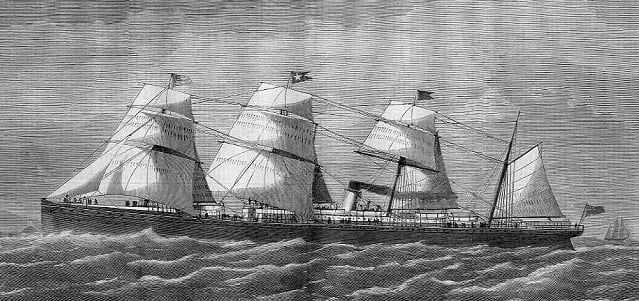SS Atlantic: A Captain's Fateful Decision
On April 1, 1873, the SS Atlantic, a half sail, half steam ship of the White Star Line, sank off the coast of Nova Scotia, Canada, with 562 lives lost. All the women, married men and all the children but one, died.
After a series of miscommunications on board the Atlantic, it went aground near Meagher’s Island, rolled over and took the majority of its passengers and crew down with it.
Captain James A. Williams was in charge and the person whom many blame for the loss of the ship.
The day before, the ship was running short of coal, and Williams feared it might not make it to New York, so he diverted to Halifax to refuel. Nova Scotia is famous for stormy seas and foggy nights, and Williams thought he was near Halifax at the time of the grounding. Rather, it was the fishing community of Lower Prospect, and the vessel hit rocky shores at full speed.
Atlantic was swamped within minutes, leaving her decks and rigging swept by waves. The struggle to leave the ship and make it to shore claimed the lives of many. Several crew members heroically swam through heavy surf and freezing water to land rescue lines and seek help. At daylight, local fisherman also braved the high seas to look for survivors.
The only child to survive was John Hindley. He was emigrating from England with his parents and older brother to join two married sisters in New Jersey. There were at least 138 women on board, most did not even succeed in reaching the deck. Some were in the lifeboats that capsized, and others were swept overboard with their children, because they did not have the strength to hang onto the rails or the rigging.
An inquiry determined that Atlantic’s engineers were incorrect in their estimate that she was short of coal. Her captain and officers were blamed for not taking precautions such as extra lookouts and soundings as they approached Halifax in darkness.
The Canadian government inquiry concluded with the statement, “the conduct of Captain Williams in the management of his ship during the twelve or fourteen hours preceding the disaster was so gravely at variance with what ought to have been the conduct of a man placed in his responsible position.”
Williams’ statement of events includes this recount: “Considered the risk too great to push on, as we might find ourselves in the event of a gale short, out from any port of supply, and so decided to bear up for Halifax, at one P.M., on the 31st, Sambro Island north five degrees, east, distant 170 miles, ship's speed varying from eight knots an hour to twelve; wind south during the first part with rain; veered to the westward at eight P.M., with clear weather at midnight; judged the ship to have made 122 miles, which would place her 48 miles south of Sambro.
“I then left the deck and went into the chart-room leaving orders about the lookouts and to let me know if they saw anything, and call me at three A.M., intending then to put the ship's head off to the southward, and await daylight. My first intimation of the catastrophe, was the striking of the ship on Mar's Island, and remaining fast. The sea immediately swept away all the port boats.”
 Atlantic
Atlantic
The loss of Atlantic was the worst ocean liner disaster in history until the sinking of White Star Line’s Titanic when over 1,500 people died.
Like Titanic, Atlantic was one of the largest and grandest ships afloat at the time of her loss. Atlantic had sailed for New York on her maiden voyage just two years earlier in June 1871. Still rigged for auxiliary sail, her primary propulsion was steam. She was fitted with the newest generation of compound steam engines, cutting coal consumption in half. She had an extremely long thin hull (a length to beam ratio of 10 to 1) and some of the most luxurious and comfortable first class accommodations seen on the North Atlantic.
Other White Star Line ships lost in the North Atlantic include Naronic, lost at sea under mysterious circumstances in 1893 with 74 lives lost, and Republic, sunk as a result of a collision in 1909, with over 1,500 lives saved.
Williams’ account can be read here.
